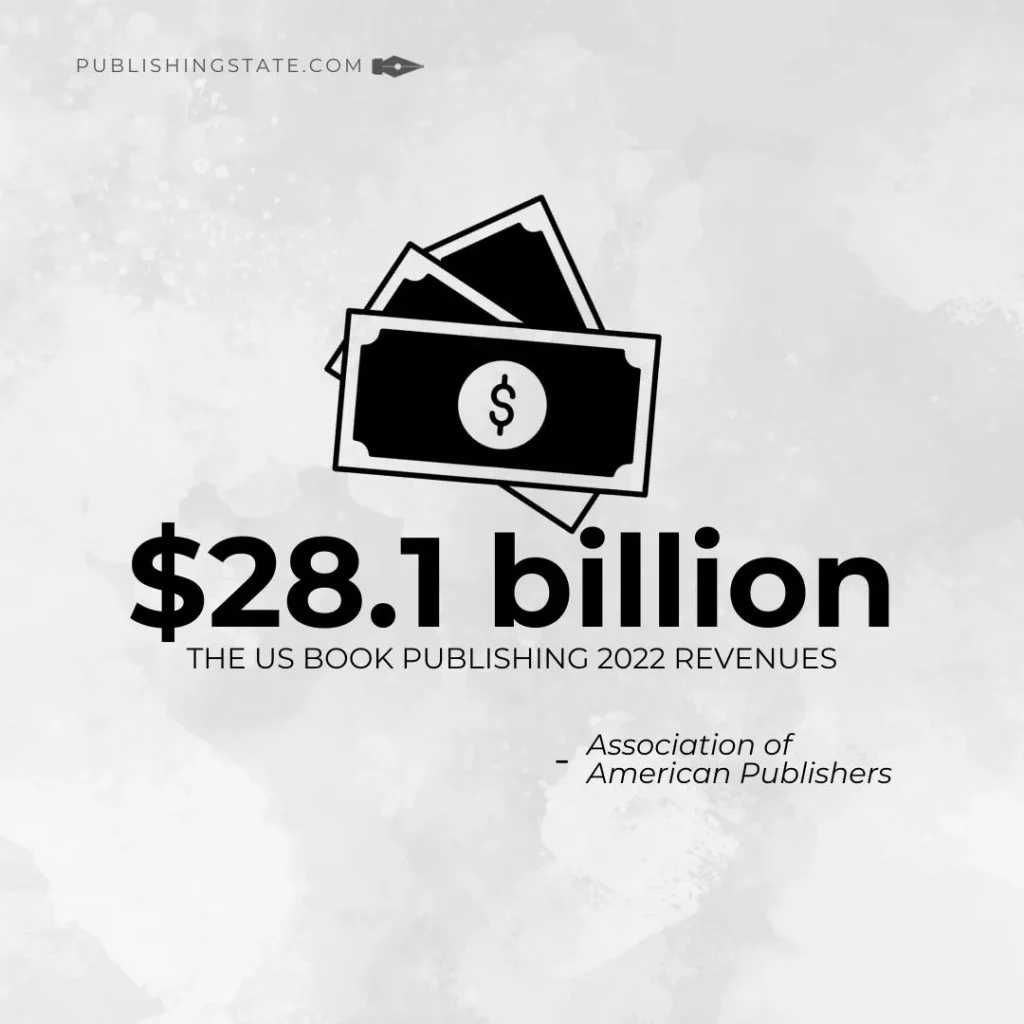Table of Contents
- Introduction
- The Anatomy of the US Book Publishing Market
- The Economic Impact of the US Book Publishing Market
- Understanding Market Trends in US Book Publishing
- Key Challenges Facing the US Book Publishing Market
- Opportunities in the US Book Publishing Market
- Navigating Your Way in the US Book Publishing Market
- Conclusion
Introduction
This write-up analyzes the US book publishing market, covering the financial values, interesting figures and facts, economic impacts, emerging trends, key challenges, and opportunities. The industry is teeming with creativity and innovation, and a rich tapestry of stories is waiting to be told.

The US book publishing market is a significant entity in the global literary scene, contributing both culturally and economically. The US holds the largest share in the global book industry, accounting for over 25% of the total revenues, with signs of continued growth.
This market encompasses various components, from publishers and authors to distributors and readers. It is an ever-evolving, dynamic field with technological advancements and changing consumer trends.
Here, we’ll delve deeper into this fascinating world of US publishing, dissecting its anatomy, evaluating its economic impact, and understanding current market trends. We’ll also address some of the industry’s challenges and explore potential growth opportunities. Furthermore, we’ll offer practical advice for navigating this complex yet rewarding market.
Whether you’re an aspiring author, an established publisher, or an avid reader interested in the behind-the-scenes workings of the book world, there’s something here for everyone. So, buckle up and prepare for an enlightening journey through the US book publishing landscape.
The Anatomy of the US Book Publishing Market
To understand the anatomy of the US book publishing market, we need to delve into its key components: publishers, authors, distributors, retailers, and readers. Each plays a unique role in making this industry survive and thrive.
Publishers, Authors, Distributors, Retailers, and Readers
Let’s start at the beginning, with the authors. These inventive individuals craft stories and ideas into words, creating the raw material that fuels the market.
Once a manuscript is ready, it’s time for the publishers to step in. Traditional publishers, often large companies with abundant resources, take on the responsibility of turning the author’s manuscript into a polished, marketable book. They handle editing, typesetting, cover design, marketing, and more.
Once the book is ready, distributors enter the scene. They ensure the book reaches various sales channels, from brick-and-mortar bookstores to online platforms. Retailers, the next link in the chain, sell the books directly to the ultimate driving force of the market – the readers.
Readers’ tastes, preferences, and buying habits are pivotal in shaping the market’s direction. Their demand ultimately decides what gets published and what fades away. Without the avid reader, the book publishing market would cease to exist.
Types of Publishing
Over the years, the publishing landscape has evolved significantly, resulting in diverse publishing avenues. Let’s explore these in detail.
As previously mentioned, traditional publishing involves an established publishing house taking on the bulk of the work to transform a manuscript into a sellable book. While this model provides wide reach and professional expertise, it can be challenging for new authors due to its highly selective nature.
Self-publishing is an alternative route where you take on the roles of both writer and publisher. You manage everything from editing to marketing, often hiring professionals to help out. While it requires more effort, self-publishing offers greater creative control and royalty rates.
The rise of technology has also given birth to digital publishing and print-on-demand services. Digital publishing refers to electronic digital books, often on devices like e-readers, tablets, or smartphones. On the other hand, print-on-demand allows books to be printed as and when orders come in, reducing storage costs and waste.
Each type of publishing has its advantages and challenges. Choosing the right path depends mainly on the author’s resources, goals, and personal preferences.
There you have it – a comprehensive breakdown of the US book publishing market’s anatomy. Stay tuned for an in-depth discussion of the economic impact of this fascinating industry in the next section.
The Economic Impact of the US Book Publishing Market
The financial value of the US book publishing market is immense, with significant implications for the country’s economy.
The Value of the US Book Publishing Market
The US book publishing market is dynamic and evolving, with several interesting facts and figures highlighting its significance. According to the Association of American Publishers, the total 2022 revenues of the US book publishing sector are estimated to be around $28.10 billion.

This figure shows a substantial economic presence. It includes sales from various forms of publishing, such as traditional publishing, self-publishing, digital publishing, and print-on-demand, as discussed in the previous section.
The industry is dominated by five major publishing houses, often called the “Big Five.” These include Penguin Random House, Hachette Book Group, Harper Collins, Simon and Schuster, and Macmillan. Penguin Random House is the United States’s largest publisher, boasting over 90 imprints and releasing 2,000 books annually.
These billions of dollars are not just random numbers. They reflect the hard work of countless authors, editors, designers, marketers, retailers, and many others involved in bringing a book from an idea to a physical or digital product that readers can enjoy.
The US book publishing industry employed 72,008 people as of 2022, with an average annual growth of 513.44 employees. The average salary for men in the industry was $80,000 as of 2021, while for women, it was $62,750.
In other words, the financial value of the book publishing market also represents the livelihoods of many people who make their living from books.
From a global perspective, the book industry continues to grow, with projections indicating that the book publishing market is estimated to reach $99.9 billion in 2022 and is expected to reach $108.8 billion by 2030. This represents a Compound Annual Growth Rate (CAGR) of 1.1% from 2022-2030.
Contribution to the US Economy
Let’s look at how this market contributes to the US economy. The book publishing industry doesn’t exist in isolation. It has numerous links to other sectors, generating a ripple effect throughout the economy.
For instance, book creation involves writing, printing, marketing, distribution, and retailing. Each stage generates economic activity, including jobs and profits for businesses.
Furthermore, the book publishing industry significantly contributes to the US’s cultural exports. American-authored books are read and cherished worldwide, earning foreign revenue and enhancing the nation’s soft power. The US book market also attracts international authors and publishers who aspire to reach a vast and diverse American audience.
In addition, the book publishing industry indirectly supports economic growth by fostering education and learning. Books are crucial tools for knowledge dissemination, encouraging research and innovation. They support a well-educated workforce, which is essential for a competitive economy.
Simply put, the US book publishing market is more than an industry. It’s a significant component of the country’s economic engine, driving growth, supporting jobs, and fostering cultural exchange and innovation.
As we discuss market trends, challenges, and opportunities in the following sections, keep this economic importance in mind. The impact of the book publishing market extends far beyond the pages of the books it produces.
Understanding Market Trends in US Book Publishing
The US book publishing market is dynamic, constantly evolving with technological advancements and changing consumer habits.
One of the most notable trends of the last decade has been the rise of digital reading platforms and audiobooks. This shift toward digital media is reshaping the publishing landscape, offering both challenges and opportunities for authors, publishers, and readers alike.
The Rise of Audiobooks and Digital Reading Platforms
Audiobooks have emerged as a popular format for consuming literature.
In 2022, the global audiobook market was valued at $5.4 billion and was anticipated to reach $6.9 billion in 2023. The audiobook market is also projected to reach $35.04 billion by 2030, expanding at a compound annual growth rate (CAGR) of 26.3% from 2023 to 2030.

This rise of audiobooks can be attributed to several factors, including the convenience of consuming books while performing other tasks, the immersive experience of narration, and the widespread availability of audiobook platforms such as Audible and Google Play Books.
Simultaneously, digital reading platforms are gaining traction. E-books offer benefits such as portability and accessibility, and they often have lower prices than print books. The advent of e-readers like Amazon’s Kindle and reading apps on smartphones and tablets has made it easier for consumers to access a vast array of titles at their fingertips.
Changing Consumer Habits and Their Influence
These trends are closely tied to shifting consumer habits. Today’s readers, particularly younger generations, are digital natives who value convenience and immediacy. The ability to download an e-book or audiobook instantly meets these needs, as does the capability to carry an entire library on a single device. These conveniences, coupled with a growing interest in multitasking, have driven the uptake of digital formats.
Furthermore, the COVID-19 pandemic has accelerated these trends. With physical bookstores temporarily closed and more people at home, many turned to digital reading platforms for entertainment and learning. This shift may have long-term implications, with some consumers likely to stick with digital formats even after physical stores reopen.
However, it’s important to note that despite the rise in digital consumption, print books still hold a significant market share. The tactile experience of reading a physical book, the joy of owning a personal library, and the pleasure of browsing in a bookstore continue to appeal to many readers.
According to the Pew Research Center, 65% of Americans reported reading a print book in the past year, compared to 28% who read an e-book and 14% who listened to an audiobook.
Understanding these market trends is crucial for anyone in the US book publishing industry. By staying informed about shifts in consumer preferences and technological advancements, publishers and authors can make strategic decisions to navigate this rapidly evolving landscape.
Key Challenges Facing the US Book Publishing Market
Let us discuss some of the key challenges currently ruffling the US book publishing market pages. We’ll explore issues such as copyright infringement, piracy, and the rise of self-publishing while also considering the industry’s response to these hurdles.
Copyright Infringement and Piracy
The advent of digital technology has undeniably revolutionized the book publishing industry. However, this evolution has also brought a surge in copyright infringement and piracy activities.
With the click of a button, unauthorized copies can be distributed worldwide, resulting in significant losses for authors and publishers. This not only diminishes the financial viability of the industry but also devalues the painstaking work of creative minds.
Copyright infringement and piracy also create ethical dilemmas besides the financial implications. Authors’ rights to control the distribution and modification of their work are often violated, leading to moral and legal concerns.
The industry, however, is not sitting idle against these infractions. There have been robust legal actions and the implementation of advanced digital rights management (DRM) systems to curb unlicensed distribution of works. Yet, the effectiveness of these measures remains an ongoing topic of debate.
The Advent of Self-Publishing
Another significant challenge impacting the traditional pillars of the US book publishing industry is the rise of self-publishing. With platforms like Amazon Kindle Direct Publishing and Smashwords, authors now have the tools to bypass traditional publishers entirely. They can directly reach readers, maintain more control over their work, and often earn a higher share of sales proceeds.
While this democratization of publishing is a boon for many authors, it presents a challenge for traditional publishers. They find attracting and retaining authors increasingly difficult, especially when they can’t match self-publishing platforms’ financial incentives or creative control.
Despite this, traditional publishers still hold several advantages. They provide author services such as editing, design, marketing, and distribution that self-publishing authors often struggle with. Traditional publishers strive to maintain relevance in the evolving publishing landscape by leveraging these strengths and adapting to changing market dynamics.
As we’ve seen, the US book publishing market is navigating a tumultuous sea of challenges. Yet, these challenges lie opportunities for innovation, adaptation, and growth. The next section will explore these potential opportunities and how aspiring authors and industry players can seize them.
Opportunities in the US Book Publishing Market
Opportunities are aplenty in an ever-evolving landscape like the US book publishing market. New genres, technological advancements, and niche markets herald a promising future for aspiring authors and publishers. This section explores these burgeoning opportunities and discusses how they can be leveraged effectively.
New Genres and Niche Markets
The US book publishing market is continually expanding with the emergence of new genres and niche markets. Young adult fiction, graphic novels, and diverse literature are becoming increasingly popular. Readers seek more authentic and varied experiences through books, creating opportunities for authors and publishers to break away from traditional genres and explore untapped niches.
For instance, there’s been a surge in interest in books that address social issues or represent underrepresented groups. Works that promote diversity, inclusion, and social justice are gaining traction. This trend presents a window of opportunity for authors who can bring fresh perspectives and narratives into the spotlight.
Technological Advancements
Technology has revolutionized the book publishing industry, offering significant opportunities. E-books, audiobooks, and digital reading platforms have become popular as they cater to the busy, tech-savvy consumer. Furthermore, technology has made it easier for authors to self-publish and distribute their works, bypassing traditional publishing routes.
Virtual reality (VR) and augmented reality (AR) technologies are gradually entering the publishing industry, creating immersive reading experiences. Publishers harnessing these technologies can set themselves apart in a competitive market.
Leveraging Opportunities: Advice for Aspiring Authors and Publishers
These opportunities present an exciting chance for aspiring authors and publishers to make their mark in the industry. Here are a few strategies:
- Identify and Understand Your Niche: Understanding your target audience’s preferences is crucial. Tailor your content to meet their interests and needs.
- Embrace Technology: Utilize digital platforms for publishing and promoting your work. Stay ahead of tech trends and consider how they can enhance your readers’ experience.
- Publish Diverse Content: As readers seek more diverse and inclusive content, consider how your work can contribute to this growing demand.
These opportunities in the US book publishing market are just the tip of the iceberg. Authors and publishers can navigate this dynamic landscape successfully with creativity, adaptability, and an understanding of market trends.
Navigating Your Way in the US Book Publishing Market
The intricacies of the US book publishing market can seem daunting, especially for newcomers. Fear not. We have practical tips and strategies to help you break into or succeed in this dynamic industry. Let’s dive deeper into understanding contracts, choosing the right publisher, marketing your book, and more.
Understanding Contracts
Contracts are one of the most crucial aspects of the publishing process, yet they can be complex and difficult to navigate. Reading and understanding every aspect of your contract thoroughly is essential before signing. Look out for clauses about royalties, copyright ownership, and termination. If possible, consider getting legal advice to protect your rights as an author.
Choosing the Right Publisher
Picking the perfect publisher is another critical decision. Research prospective publishers to understand their genre specializations, market reach, and reputation. You may want to consider whether they have successfully published similar works and how effective their marketing strategies are. Remember, a good publisher should align with your vision and work tirelessly to make your book successful.
Marketing Your Book
Even the most compelling books can’t sell themselves. Effective marketing is key to getting your book noticed and purchased. Start building an author platform well before your book comes out – engage with readers through social media, blog posts, and other online platforms. Consider hiring a publicist or marketing expert if you have the budget. And don’t forget about local opportunities such as book signings, author talks, and networking events.
The Importance of a Good Editor
No matter how talented you are as a writer, a good editor can make your work shine even brighter. They can catch mistakes, offer constructive criticism, and provide valuable insights that significantly improve your manuscript. Investing in professional editing services may seem expensive, but it can greatly enhance the quality of your book.
Embracing Technology
The rise of e-books, audiobooks, and digital reading platforms has revolutionized the publishing industry. Embrace this change by considering these formats for your book. They can increase accessibility and reach a wider audience. Plus, digital platforms often offer more favorable terms for authors, such as higher royalty rates. Stay up to date with the latest technological advancements and trends in the industry to ensure you’re making the most of these opportunities.
Being Resilient and Adaptable
The publishing industry can be challenging and competitive, but it’s essential to remain resilient and adaptable. Be prepared for rejection and setbacks, but don’t let them discourage you. Learn from feedback and use it to improve your craft. Stay open to new ideas and be willing to adapt your approach based on market trends and reader feedback. Persistence, creativity, and a willingness to learn and grow are key to long-term success in this dynamic landscape.
Conclusion
Based on the figures and the discussions on trends, challenges, and opportunities, the US book publishing market is dynamic and thriving, providing immense opportunities for authors, publishers, distributors, and readers. With its economic significance, technological advancements, and changing consumer trends, this market is as captivating as the stories it tells.
This article has provided an informed look into the US book publishing market, imparting valuable insights into its financial values, economic impacts, trends, challenges, and growth opportunities. With the right guidance and knowledge, anyone can take advantage of this lucrative market’s various elements.
